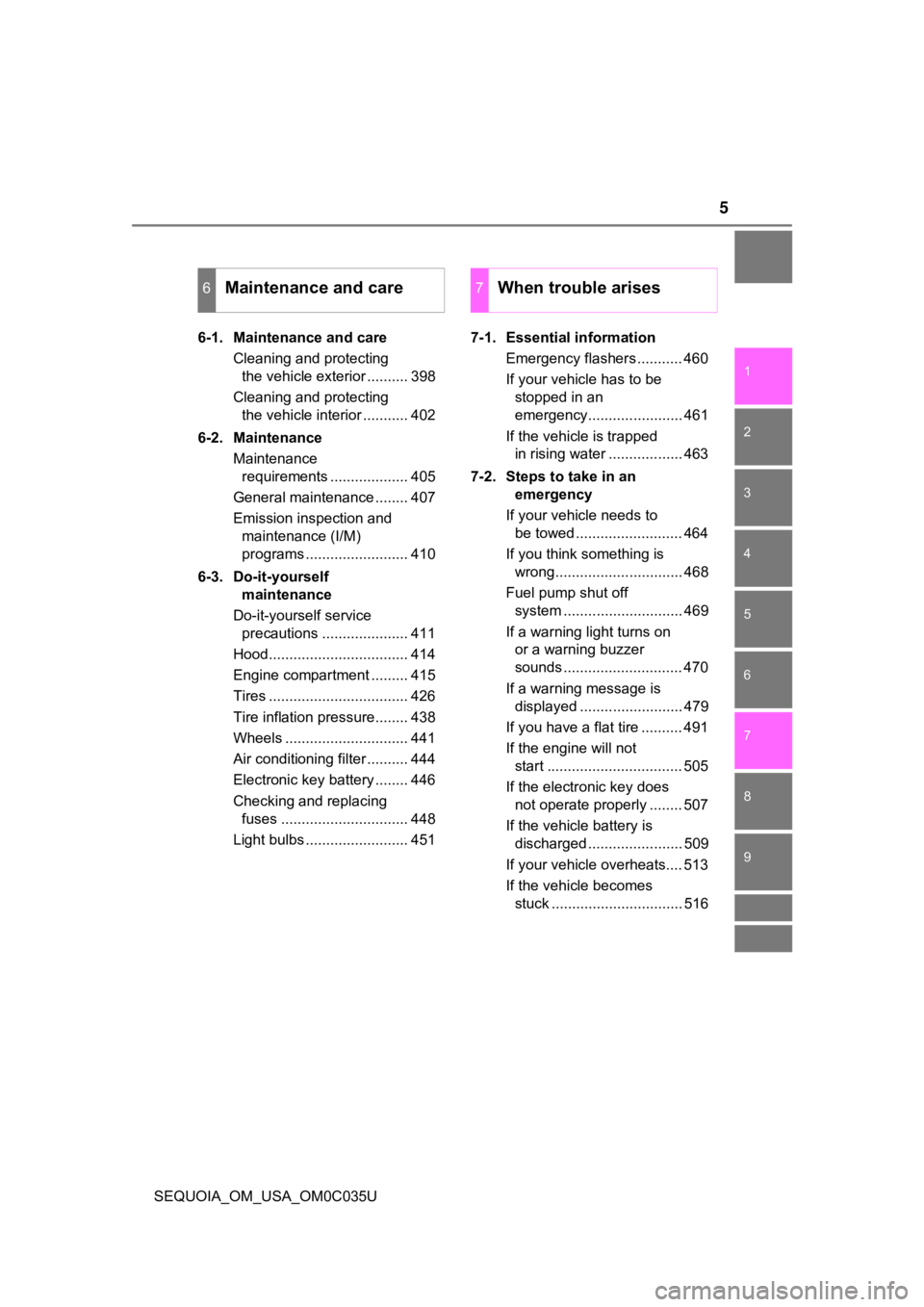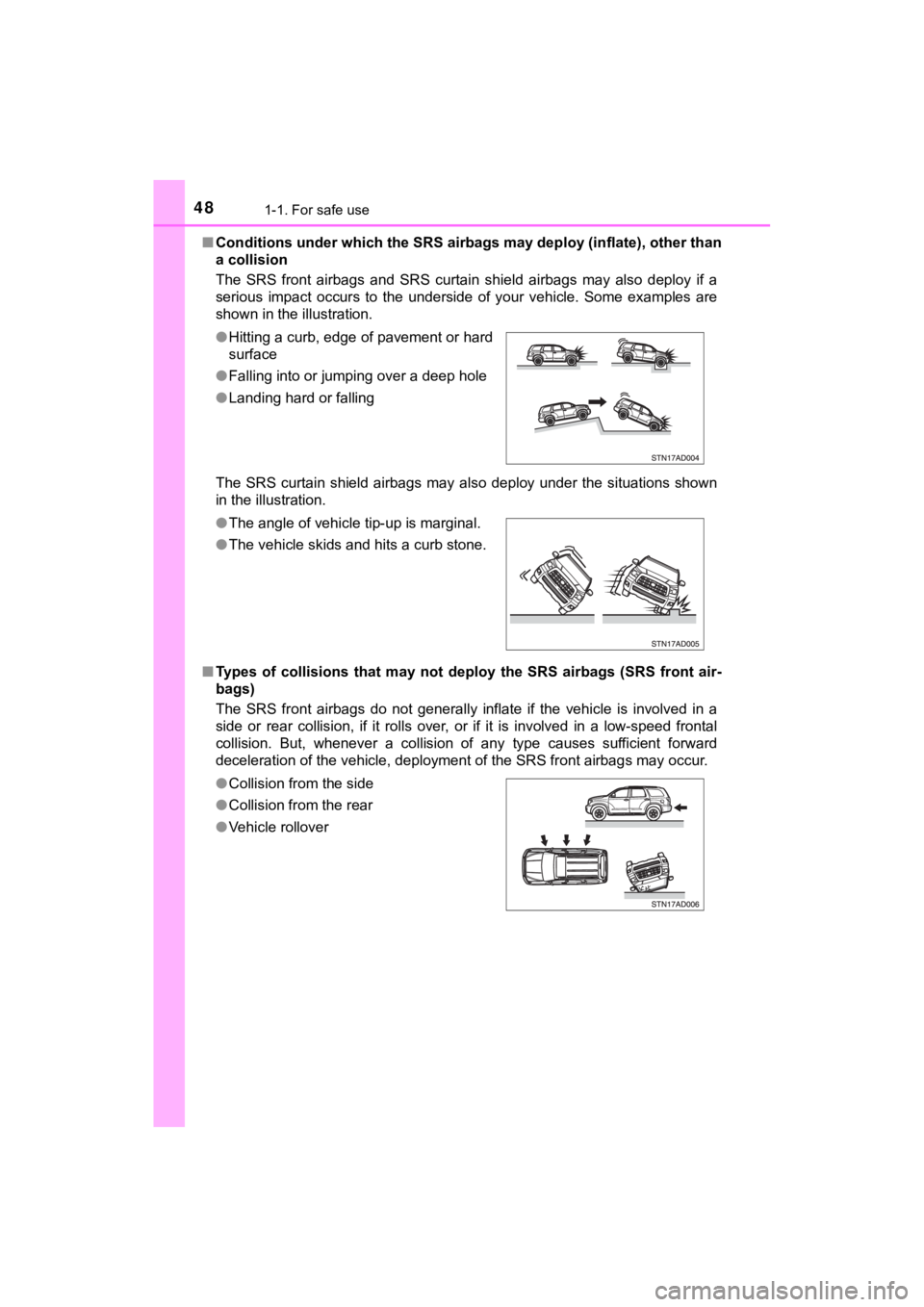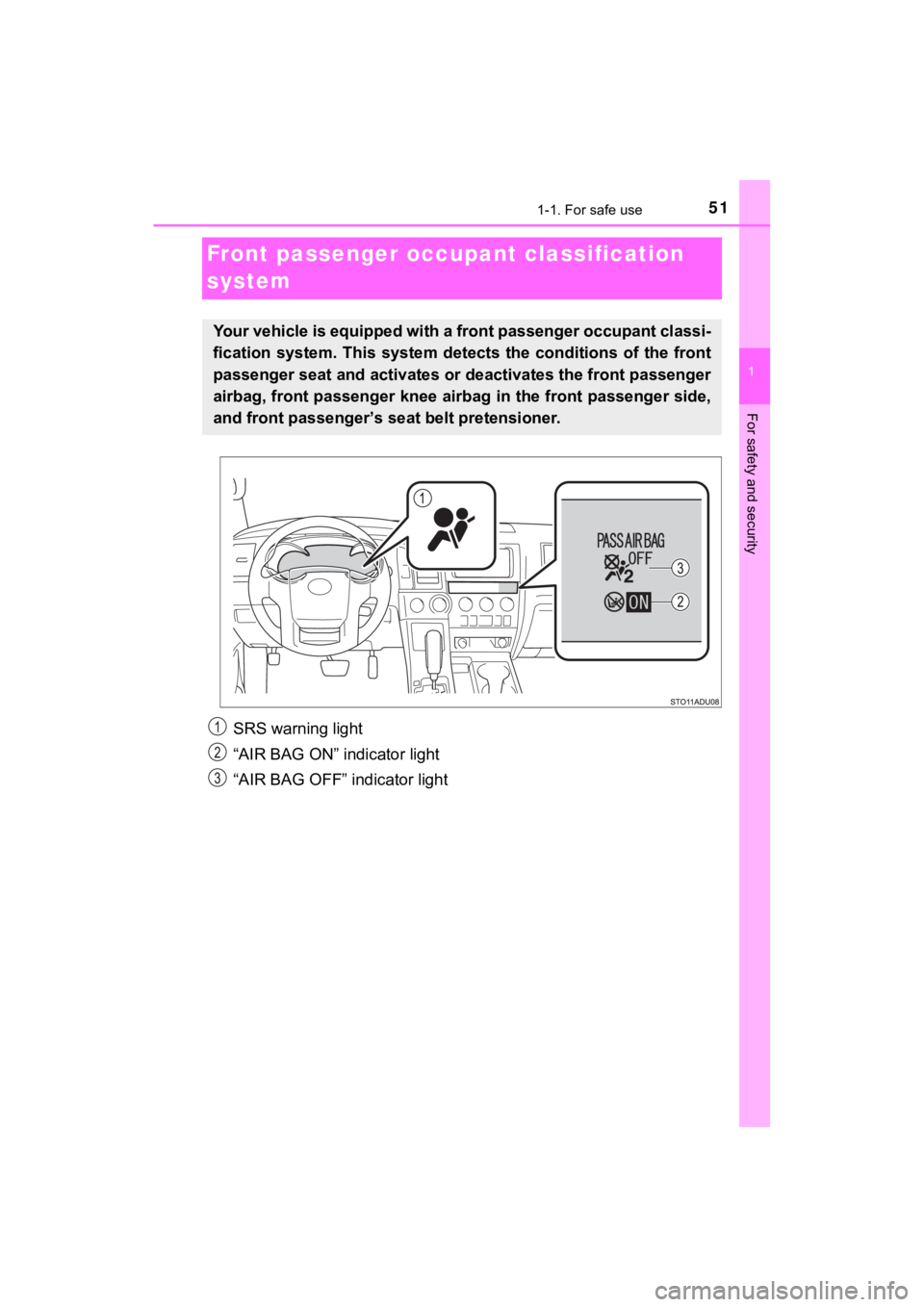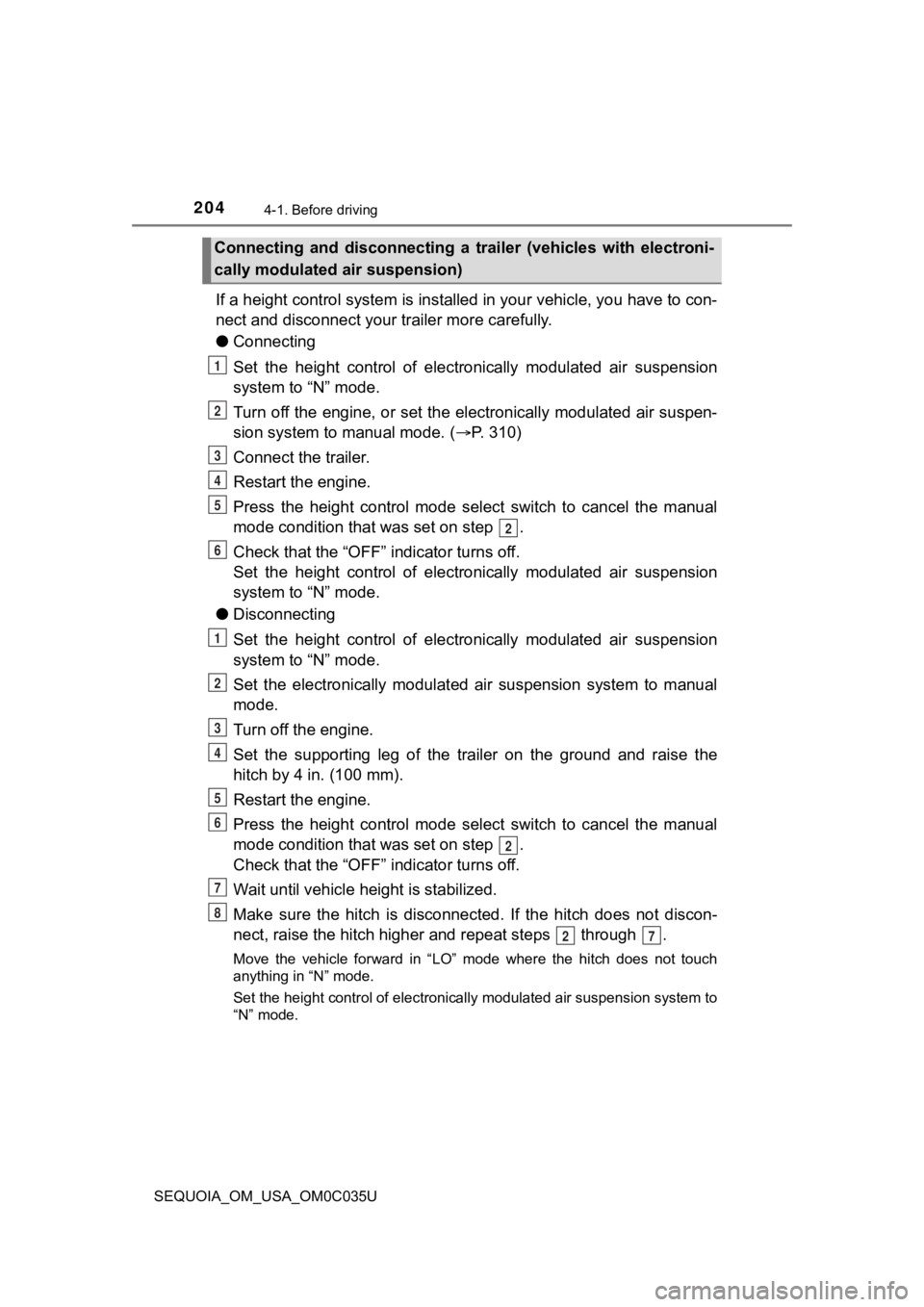air condition TOYOTA SEQUOIA 2021 Owners Manual (in English)
[x] Cancel search | Manufacturer: TOYOTA, Model Year: 2021, Model line: SEQUOIA, Model: TOYOTA SEQUOIA 2021Pages: 588, PDF Size: 12.76 MB
Page 4 of 588

TABLE OF CONTENTS4
SEQUOIA_OM_USA_OM0C035U5-1. Using the air conditioning
system and defogger
Front air conditioning system............................. 340
Rear air conditioning system............................. 348
Seat heaters/ seat ventilators ................ 352
5-2. Using the interior lights Interior lights list ................ 355
• Personal/interior light main switch ................... 356
• Personal/interior lights ............................. 357
• Interior light ................... 358
5-3. Using the storage features
List of storage features...... 359
• Glove boxes .................. 360
• Front console box ......... 361
• Card holder ................... 362
• Map holder (center console) ............ 363
• Rear console box .......... 363
• Overhead console ......... 365
• Cup holders .................. 366
• Bottle holders ................ 369
• Auxiliary boxes .............. 370
Luggage compartment features ........................... 371 5-4. Other interior features
Other interior features........ 375
• Sun visors ..................... 375
• Vanity mirrors ................ 376
• Power outlets ................ 377
• USB charging ports ....... 380
• Armrest (second seats)............... 382
• Rear side sunshades .... 383
• Assist grips .................... 384
Garage door opener .......... 385
Compass ........................... 393
5Interior features
Page 5 of 588

5
1
8 7
6
5
4
3
2
9
SEQUOIA_OM_USA_OM0C035U6-1. Maintenance and care
Cleaning and protecting the vehicle exterior .......... 398
Cleaning and protecting the vehicle interior ........... 402
6-2. Maintenance Maintenance requirements ................... 405
General maintenance ........ 407
Emission inspection and maintenance (I/M)
programs ......................... 410
6-3. Do-it-yourself maintenance
Do-it-yourself service precautions ..................... 411
Hood.................................. 414
Engine compartment ......... 415
Tires .................................. 426
Tire inflation pressure........ 438
Wheels .............................. 441
Air conditioning filter .......... 444
Electronic key battery ........ 446
Checking and replacing fuses ............................... 448
Light bulbs ......................... 451 7-1. Essential information
Emergency flashers ........... 460
If your vehicle has to be stopped in an
emergency....................... 461
If the vehicle is trapped in rising water .................. 463
7-2. Steps to take in an emergency
If your vehicle needs to be towed .......................... 464
If you think something is wrong............................... 468
Fuel pump shut off system ............................. 469
If a warning light turns on or a warning buzzer
sounds ............................. 470
If a warning message is displayed ......................... 479
If you have a flat tire .......... 491
If the engine will not start ................................. 505
If the electronic key does not operate properly ........ 507
If the vehicle battery is discharged ....................... 509
If your vehicle overheats.... 513
If the vehicle becomes stuck ................................ 516
6Maintenance and care7When trouble arises
Page 19 of 588

19Pictorial index
SEQUOIA_OM_USA_OM0C035UMulti-information display . . . . . . . . . . . . . . . . . . . . . . . . . . . . P. 98
Display . . . . . . . . . . . . . . . . . . . . . . . . . . . . . . . . . . . . . . . . . . . . P. 98
When the warning messages are displayed . . . . . . . . . . . . . . P. 479
Parking brake pedal. . . . . . . . . . . . . . . . . . . . . .
. . . . . . . . . . P. 226
Applying/releasing . . . . . . . . . . . . . . . . . . . . . . . . . . . . . . . . . . P. 226
Precautions against winter season . . . . . . . . . . . . . . . . . . . . . P. 335
Warning buzzer/message . . . . . . . . . . . . . . . . . . . . . . . . . . . . P. 482
Turn signal lever . . . . . . . . . . . . . . . . . . . . . . . . . . . . . . . . . . P. 225
Headlight switch . . . . . . . . . . . . . . . . . . . . . . . . . . . . . . . . . . P. 227
Headlights/parking lights/side marker lights/tail lights/
daytime running lights . . . . . . . . . . . . . . . . . . . . . . . . . . . . . . . P. 227
Fog lights . . . . . . . . . . . . . . . . . . . . . . . . . . . . . . . . . . . . . . . . . P. 236
Windshield wipers and washer switch . . . . . . . . . . . . . . . . P. 238
Rear window wiper and washer switch . . . . . . . . . . . . . . . . P. 241
Usage . . . . . . . . . . . . . . . . . . . . . . . . . . . . . . . . . . . . . . . P. 238, 241
Adding washer fluid . . . . . . . . . . . . . . . . . . . . . . . . . . . . . . . . . P. 425
Warning message . . . . . . . . . . . . . . . . . . . . . . . . . . . . . . . . . . P. 483
Emergency flasher switch . . . . . . . . . . . . . . . . . . . . . . . . . . P. 460
Hood lock release lever. . . . . . . . . . . . . . . . . . . . . . . . . . . . . P. 414
Tilt and telescopic steering lock release lever
*1 . . . . . . . . P. 156
Tilt and telescopic steering control switch
*1 . . . . . . . . . . . P. 156
Adjustment . . . . . . . . . . . . . . . . . . . . . . . . . . . . . . . . . . . . . . . . P. 156
Driving position memory . . . . . . . . . . . . . . . . . . . . . . . . . . . . . P. 149
Front air conditioning system . . . . . . . . . . . . . . . . . . . . . . . P. 340
Usage . . . . . . . . . . . . . . . . . . . . . . . . . . . . . . . . . . . . . . . . . . . P. 340
Rear window defogger . . . . . . . . . . . . . . . . . . . . . . . . . . . . . . . P. 343
Multimedia system
*2
*1: If equipped
*2: Refer to “NAVIGATION AND MULT IMEDIA SYSTEM OWNER’S MANUAL”.
Page 47 of 588

471-1. For safe use
1
For safety and security
SEQUOIA_OM_USA_OM0C035U■
SRS airbag deployment condi tions (SRS front airbags)
● The SRS front airbags will deploy in the event of an impact tha t exceeds the
set threshold level (the level of force corresponding to an approximately 12 -
18 mph [20 - 30 km/h] frontal collision with a fixed wall that does not move or
deform).
However, this threshold velocity will be considerably higher in the following
situations:
• If the vehicle strikes an object, such as a parked vehicle or sign pole,
which can move or deform on impact
• If the vehicle is involved in an underride collision, such as a collision in
which the front of the vehicle “underrides”, or goes under, the bed of a
truck
● The SRS front airbags for the front passenger will not activate if there is no
passenger sitting in the front passenger seat. However, the SRS front air-
bags for the front passenger may deploy if luggage is put in the seat, even if
the seat is unoccupied.
■ SRS airbag deployment conditions (SRS side and curtain shield a irbags)
● The SRS side and curtain shield airbags will deploy in the even t of an
impact that exceeds the set threshold level (the level of force corresponding
to the impact force produced by an approximately 3300 lb. [1500 kg] vehicle
colliding with the vehicle cabin from a direction perpendicular to the vehicle
orientation at an approximate speed of 12 - 18 mph [20 - 30 km/ h]).
● Both SRS curtain shield airbags will deploy in the event of veh icle rollover.
● Both SRS curtain shield airbags may also deploy in the event of a severe
frontal collision.
Page 48 of 588

481-1. For safe use
SEQUOIA_OM_USA_OM0C035U■
Conditions under which the SRS ai rbags may deploy (inflate), other than
a collision
The SRS front airbags and SRS curtain shield airbags may also d eploy if a
serious impact occurs to the underside of your vehicle. Some ex amples are
shown in the illustration.
The SRS curtain shield airbags may also deploy under the situat ions shown
in the illustration.
■ Types of collisions that may not deploy the SRS airbags (SRS fr ont air-
bags)
The SRS front airbags do not generally inflate if the vehicle i s involved in a
side or rear collision, if it rolls over, or if it is involved in a low-speed frontal
collision. But, whenever a collision of any type causes suffici ent forward
deceleration of the vehicle, deployment of the SRS front airbag s may occur.
●
Hitting a curb, edge of pavement or hard
surface
● Falling into or jumping over a deep hole
● Landing hard or falling
● The angle of vehicle tip-up is marginal.
● The vehicle skids and hits a curb stone.
● Collision from the side
● Collision from the rear
● Vehicle rollover
Page 51 of 588

511-1. For safe use
1
For safety and security
SEQUOIA_OM_USA_OM0C035U
Front passenger occupant classification
system
Your vehicle is equipped with a front passenger occupant classi -
fication system. This system det ects the conditions of the front
passenger seat and activates or deactivates the front passenger
airbag, front passenger knee airbag in the front passenger side ,
and front passenger’s seat belt pretensioner.
SRS warning light
“AIR BAG ON” indicator light
“AIR BAG OFF” indicator light
Page 52 of 588

521-1. For safe use
SEQUOIA_OM_USA_OM0C035U■
Adult*1
■Child*4 or child restraint system*5
Condition and operation in the front passenger occupant classi-
fication system
Indicator/
warning light
“AIR BAG ON” and “AIR BAG OFF” indicator lights“AIR BAG ON”
SRS warning lightOff
Front passenger’s seat belt reminder lightOff*2 or
flashing
*3
Devices
Front passenger airbag
ActivatedFront passenger knee airbag
Front passenger’s seat belt pretensioner
Indicator/
warning light
“AIR BAG ON” and “AIR BAG OFF” indicator lights“AIR BAG OFF”
*6
SRS warning lightOff
Front passenger’s seat belt reminder lightOff*2 or
flashing
*3
Devices
Front passenger airbag
Deactivated
Front passenger knee airbag
Front passenger’s seat belt pretensionerActivated
Page 110 of 588

1103-1. Key information
SEQUOIA_OM_USA_OM0C035U■
When riding in an aircraft
When bringing a key with wireless remote control function onto an aircraft,
make sure you do not press any buttons on the key while inside the aircraft
cabin. If you are carrying the key in your bag, etc., ensure th at the buttons are
not likely to be pressed accidentally. Pressing a button may cause the key to
emit radio waves that could interfere with the operation of the aircraft.
■ Conditions affecting operation
P. 131
■ Key battery depletion
●The standard battery life is 1 to 2 years.
● If the battery becomes low, an alarm will sound in the cabin wh en the engine
stops. ( P. 488)
● As the electronic key always receives radio waves, the battery will become
depleted even if the electronic key is not used. The following symptoms indi-
cate that the electronic key battery may be depleted. Replace the battery
when necessary. ( P. 446)
• The smart key system or the wirel ess remote control does not oper-
ate.
• The detection area becomes smaller.
• The LED indicator on the key surface does not turn on.
●To avoid serious deterioration, do not leave the electronic key within 1 m
(3 ft.) of the following electrical appliances that produce a m agnetic field:
•TVs
• Personal computers
• Cellular phones, cordless phones and battery chargers
• Recharging cellular phones or cordless phones
• Table lamps
• Induction cookers
■Replacing the battery
P. 446
■ Confirmation of the registered key number
The number of keys already registered to the vehicle can be confirmed. Ask
your Toyota dealer for details.
■ Customization
Settings (e.g. wireless remote control system) can be changed.
(Customizable features: P. 546)
Page 131 of 588

1313-2. Opening, closing and locking the doors
3
Operation of each component
SEQUOIA_OM_USA_OM0C035U■
Conditions affecting operation
The smart key system uses weak radio waves. In the following si tuations, the
communication between the electronic key and the vehicle may be affected,
preventing the smart key system, wireless remote control and en gine immobi-
lizer system from operating properly. (Ways of coping: P. 507)
● When the electronic key battery is depleted
● Near a TV tower, electric power plant, gas station, radio stati on, large dis-
play, airport or other facility that generates strong radio wav es or electrical
noise
● When carrying a portable radio, cellular phone, cordless phone or other
wireless communication device
● When the electronic key is in contact with, or is covered by the following
metallic objects
• Cards to which aluminum foil is attached
• Cigarette boxes that have aluminum foil inside
• Metallic wallets or bags
• Coins
• Hand warmers made of metal
• Media such as CDs and DVDs
● When multiple electronic keys are in the vicinity
● When other wireless keys (that emit radio waves) are being used nearby
● When carrying the electronic key together with the following devices that
emit radio waves
• Another vehicle’s electronic key or a wireless key that emits radio waves
• Personal computers or personal digital assistants (PDAs)
• Digital audio players
• Portable game systems
● If window tint with a metallic content or metallic objects are attached to the
back window
● When the electronic key is placed near a battery charger or ele ctronic
devices
Page 204 of 588

2044-1. Before driving
SEQUOIA_OM_USA_OM0C035U
If a height control system is installed in your vehicle, you have to con-
nect and disconnect your trailer more carefully.
● Connecting
Set the height control of electronically modulated air suspensi on
system to “N” mode.
Turn off the engine, or set the electronically modulated air su spen-
sion system to manual mode. ( P. 310)
Connect the trailer.
Restart the engine.
Press the height control mode select switch to cancel the manua l
mode condition that was set on step .
Check that the “OFF” i ndicator turns off.
Set the height control of electronically modulated air suspensi on
system to “N” mode.
● Disconnecting
Set the height control of electronically modulated air suspensi on
system to “N” mode.
Set the electronically modulat ed air suspension system to manua l
mode.
Turn off the engine.
Set the supporting leg of the trailer on the ground and raise t he
hitch by 4 in. (100 mm).
Restart the engine.
Press the height control mode select switch to cancel the manua l
mode condition that was set on step .
Check that the “OFF” i ndicator turns off.
Wait until vehicle h eight is stabilized.
Make sure the hitch is disconnected. If the hitch does not disc on-
nect, raise the hitch higher and repeat steps through .
Move the vehicle forward in “LO” mode where the hitch does not touch
anything in “N” mode.
Set the height control of electronically modulated air suspensi on system to
“N” mode.
Connecting and disconnecting a trailer (vehicles with electroni -
cally modulated air suspension)
1
2
3
4
5
2
6
1
2
3
4
5
6
2
7
8
27